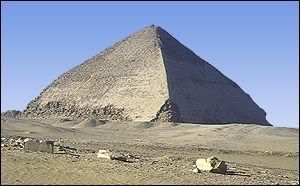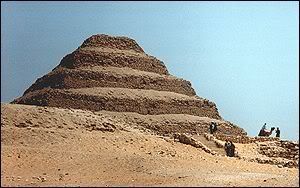Egyptian architecture has been a source of mystery and amazement for thousands of years. In a time with no modern building advancements or powered machines, the Egyptians built massive stone cities and pyramids that still stand today. They also dug intricate tombs out of stone into the sides of mountains such as the Valley of the Kings. Due to the dry climate of Egypt, wood was not in great abundance so the Egyptians made use of what they did have in abundance: mud and stone. All monumental buildings were of the post and lintel design using large flat stone roofs supported by closely spaced columns and walls.
The Temple of Ramsses II is a good example of Post and Lintel construction
Many ancient Egyptian structures still stand today attesting to the durability of their simple yet elaboratly ornamental designs. The Giza plateau holds several examples including the Pyramid of Khafre, the Pyramid of Menkaure, the Great Sphinx, and the Pyramid of Khufu, also known as the Great Pyramid. The Great Pyramid is the only still standing monument of the Seven Wonders of the Ancient World. It was constructed in 2580 BC making it over 4,500 years old and yet its majesty remains even to this day. While appearing simple from the outside, the pyramids were honeycombed with passages, tombs, antechambers, and were lavishly decorated with heiroglyphics and treasures. These were acrued during the time of the ruler that the monument was constructed for.

The Pyramids of Giza

The Bent Pyramid, of Dahshur, shows us how Egyptians experimented with slope, this one changing in mid-build.

Pharaoh Djoser built a many layered step pyramid at Saqqara in the Third Dynasty.
A crowd of tourists entering Karnak Temple
Lintel construction, Pyramids of Giza and Karnak Temple pictures courtesy of: http://en.wikipedia.org/wiki/Ancient_Egyptian_architecture
Bent pyramid and Step pyramid pictures courtesy of: http://www.ancientegypt.co.uk/pyramids/home.html